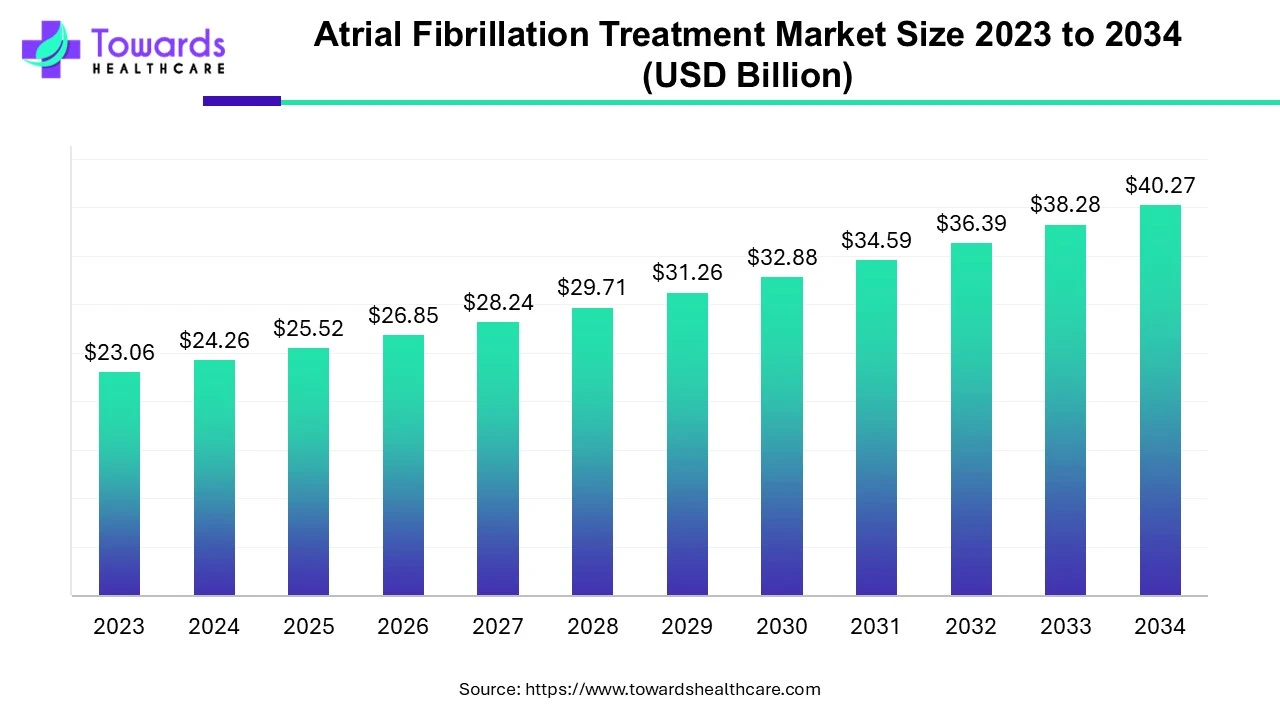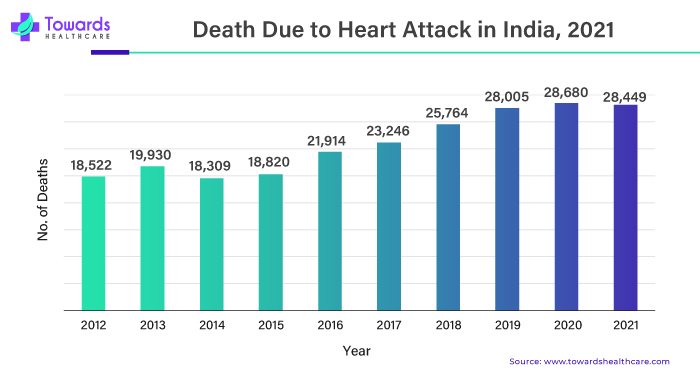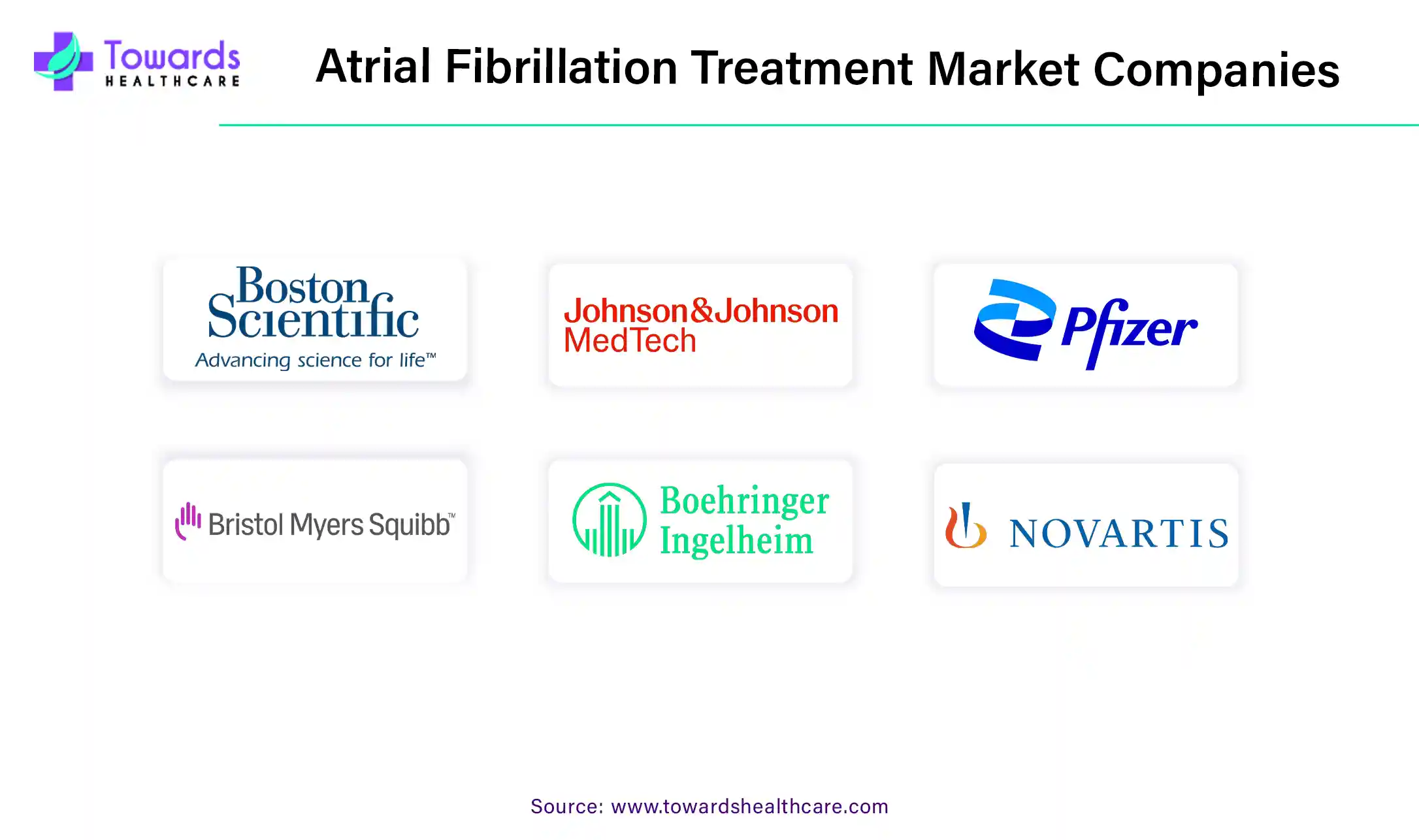April 2025

The global atrial fibrillation treatment market size is calculated at USD 24.26 billion in 2024 and is expected to be worth USD 40.27 billion by 2034, expanding at a CAGR of 5.2% from 2024 to 2034.

The National Institute of Health says atrial fibrillation is on the rise globally, especially with age. They predict that by 2050, the number of people with this condition could double or triple. This highlights the urgent need for better treatment options as the prevalence increases.
Heart and blood vessel diseases, known as cardiovascular diseases (CVDs), are increasingly prevalent, causing around 17.9 million deaths globally each year. These conditions encompass heart attacks, strokes, atrial fibrillation, and others. Heart attacks and strokes make up over 80% of CVD deaths, with one-third happening before age 70.
For instance,
Atrial fibrillation is a common problem with the heart's rhythm. It happens when the upper chambers of the heart don't beat regularly. Instead, they quiver or shake. This can make it hard for the heart to pump blood properly and can raise the chance of blood clots forming in the heart. A few things can cause atrial fibrillation, like having high blood pressure, heart disease, being overweight, having sleep problems like sleep apnea, or drinking too much alcohol. Doctors usually find atrial fibrillation by doing a test called an electrocardiogram (ECG), which checks for irregular heartbeats. It's super important to catch atrial fibrillation early because it can lead to severe problems like strokes, heart failure, and other heart issues.
Treating atrial fibrillation quickly with medications like blood thinners to stop clots from forming or procedures like catheter ablation to fix the heart's rhythm can really help manage atrial fibrillation and lower the risks. The market for treating atrial fibrillation has been growing a lot because more people are becoming aware of it, technology in medicine is getting better, and there are more risk factors like getting older and changing lifestyle habits. So, scientists are constantly working on new ways to help people with atrial fibrillation have better outcomes.

Atrial fibrillation (AF) is a condition where the heart beats irregularly and often rapidly. It is the most frequently encountered heart rhythm disorder. As the global population ages, the number of people with AF is increasing, and this trend is expected to continue. By 2050, it's projected that the number of individuals with AF could be two to three times higher than it is today.
Age is a significant factor in the prevalence of AF. While the overall global prevalence is about 1%, it becomes much more common in older adults. For instance, around 9% of people over the age of 75 have AF. The risk of developing AF increases sharply with age; by the time people reach 80 years old, their lifetime risk of having AF rises to 22%.
In addition to age, other factors influence the prevalence of AF. Men are more likely to develop AF than women. The condition is also more commonly seen in white individuals compared to black individuals.
Artificial Intelligence (AI) is poised to revolutionize the Atrial Fibrillation (AF) treatment market by enhancing diagnostic accuracy and personalizing patient care. AI algorithms can analyze vast amounts of patient data, identifying patterns that might be missed by traditional methods. This enables earlier detection and more precise classification of AF, allowing for timely and tailored interventions.
AI-driven tools can optimize treatment plans by predicting individual responses to various therapies, thereby improving outcomes and reducing the risk of complications. In the realm of ablation procedures, AI assists in mapping and targeting arrhythmic regions with greater precision, enhancing the efficacy of interventions. Additionally, AI can streamline clinical workflows, enabling healthcare providers to manage and monitor patients more efficiently.
As AI continues to integrate into the healthcare ecosystem, it is expected to drive significant growth in the AF treatment market by reducing costs, improving patient outcomes, and fostering the development of innovative therapies. The convergence of AI and AF treatment not only holds promise for enhancing clinical practice but also for expanding market opportunities through the delivery of more efficient and personalized healthcare solutions.
As people get older, they're more likely to develop atrial fibrillation because of aging and other risk factors that build up over time. With the global population aging, more and more people are being diagnosed with atrial fibrillation. This creates a big challenge for healthcare systems everywhere because it means they have to provide effective treatments for atrial fibrillation.
Atrial fibrillation is the most commonly encountered irregular heartbeat condition within the heart. Its prevalence has been on a steady rise globally. Typically, the likelihood of experiencing atrial fibrillation increases with age, with estimations suggesting a doubling or even tripling of affected individuals by the year 2050. While the worldwide occurrence of atrial fibrillation hovers around 1%, it notably spikes to about 9% among those aged 75 and older. Additionally, upon reaching 80 years of age, the risk of developing atrial fibrillation over a lifetime surges to 22%. Furthermore, research indicates that atrial fibrillation is more frequently observed in males and is more prevalent among individuals of white ethnicity compared to those of black ethnicity.
So, there's a greater need for doctors and hospitals to give good care to atrial fibrillation patients, which includes giving them medicines and doing procedures to fix their irregular heartbeats and prevent problems like blood clots and strokes. Because atrial fibrillation is becoming more common, developing new and better ways to treat it is essential. That's why much research is going on to understand atrial fibrillation better and find treatments that work well. Doctors, scientists, government officials, and groups supporting patients are all working together to tackle the many challenges of atrial fibrillation. Moreover, it's crucial to focus on preventing atrial fibrillation and catching it early to avoid complications and reduce the pressure on healthcare systems. Because atrial fibrillation is becoming more widespread, it's prompting us to invest more in research, healthcare facilities, and education to improve care and outcomes for people with this heart condition.
Advanced technology Scientists worldwide are focused on understanding atrial fibrillation and developing better treatment methods. This research is super important because it helps us figure out why atrial fibrillation happens and how to improve it. They're developing new treatments, like medicines, special devices, and procedures, to help people with atrial fibrillation feel better and live longer. These treatments aim to fix the problems in the heart's electrical system that cause atrial fibrillation and reduce the chances of severe issues like strokes.
Improvements in technology are changing how healthcare works, especially for heart problems. With more people having heart issues, there's a growing need for better tools to diagnose and treat them faster. Big companies are coming up with new ways to treat atrial fibrillation.
Additionally, significant improvements in medical technology have led to new devices that can help regulate the heart's rhythm or prevent blood clots in people with atrial fibrillation. These new tools are up-and-coming and could improve life for atrial fibrillation patients. Scientists are also looking into how lifestyle changes, like eating healthier and exercising, can help manage atrial fibrillation and make living easier.
Device:
Medication Updates:
The main goal of all this research is to find better ways to treat atrial fibrillation and improve life for people with the condition. By learning more about atrial fibrillation and trying out new ideas, scientists hope to find treatments that can ease symptoms, prevent serious problems, and improve life for people with atrial fibrillation. It's a team effort involving scientists, doctors, and groups that support patients, and it's all about ensuring everyone affected by atrial fibrillation can have a brighter future with better care and treatments.
Over the past 25 years, there has been a lot of interest in developing new tools and techniques to make ablation treatments for atrial fibrillation safer and more effective. Initially, doctors used catheters with small tips and radiofrequency energy to create tissue lesions in the heart. However, they started using catheters with irrigation and measuring contact force over time to improve accuracy and power. Additionally, they developed single-shot devices like balloons to create more extensive lesions, and they switched to using cryogenic and electrical current for ablation. Thanks to these advancements in ablation techniques, it has become easier to treat atrial fibrillation.
For instance,
Catheter ablation techniques have entirely changed how doctors treat atrial fibrillation, providing a less invasive option compared to traditional surgery. With catheters inserted through blood vessels, doctors can precisely target and remove abnormal heart tissue causing atrial fibrillation, which helps restore a normal heart rhythm. This approach means patients don't need open-heart surgery, so they spend less time in the hospital and recover faster. Catheter ablation has also proven to be more effective than just taking medication for managing atrial fibrillation symptoms and preventing complications like strokes. Because it's prosperous and safer, more patients and doctors prefer catheter ablation, significantly increasing demand for these procedures.
Furthermore, ongoing improvements in catheter technology and techniques make atrial fibrillation ablation even better and safer. Catheter ablation has become a crucial part of managing atrial fibrillation, giving hope to many people with this common heart problem.
By end-user, the hospital segment held a dominant presence in the atrial fibrillation market in 2023. The increasing number of patients in hospitals due to the presence of multidisciplinary teams and departments and suitable infrastructure boosts the segment’s growth. The segment growth is also driven by favorable reimbursement policies and regulatory frameworks.
By end-user, the specialty clinics segment is expected to grow at the fastest rate in the market during the forecast period. Specialty clinics contain advanced treatment options through the availability of specified instruments. The presence of skilled professionals and the provision of personalized therapy increase the demand for specialty clinics globally. The increasing number of specialty clinics due to increasing incidences of cardiovascular disorders promotes the segment’s growth.
Even with all the progress made in finding and treating atrial fibrillation, there are still significant problems with not spotting it early enough or not giving the proper treatment. A lot of people who have atrial fibrillation don't even know they have it, or they don't get the appropriate treatment for it. This is a big deal because they're at higher risk of severe problems. If atrial fibrillation is missed and treated early, it can lead to complications like strokes or heart failure. There are a few reasons why this happens. Sometimes, atrial fibrillation doesn't show any apparent symptoms, so people don't realize there's a problem.
Other times, healthcare providers might not think to check for atrial fibrillation, especially if a person doesn't have any symptoms. This can lead to missed opportunities for diagnosis and treatment. Also, even if atrial fibrillation is diagnosed, not everyone gets the proper treatment. This could be due to various factors like lack of awareness about atrial fibrillation or limited access to healthcare. Addressing these issues is crucial to improving outcomes for people with atrial fibrillation and reducing the risk of complications. This includes raising awareness about atrial fibrillation, improving access to healthcare, and ensuring that healthcare providers are appropriately screening for and treating atrial fibrillation.
North America is expected to be at the forefront of the market because there are more cases of atrial fibrillation there, and many people are affected. Additionally, large companies in the region contribute to this leading position. According to the CDC, it's predicted that by 2030, around 12.1 million individuals in the United States will have atrial fibrillation. As people get older, there will be an increasing need for treatments for atrial fibrillation in the coming years.
In many parts of Asia-Pacific, there is a growing burden of cardiovascular diseases, including AFib, driven by factors such as aging populations, urbanization, and lifestyle changes. However, awareness and access to atrial fibrillation diagnosis and treatment may be limited in some areas, particularly in rural or underserved communities. On the other hand, in less developed or rural regions of the Asia-Pacific, there may be challenges in accessing healthcare services, including atrial fibrillation screening, diagnosis and treatment. More resources, healthcare infrastructure, and healthcare provider expertise may help effective management of atrial fibrillation in these areas. Cultural beliefs and practices can also influence healthcare-seeking behaviors and adherence to treatment regimens among individuals with atrial fibrillation in the Asia-Pacific region. Customized interventions to address cultural preferences and practices are essential for improving outcomes and reducing disparities in atrial fibrillation care.
In the market for treating atrial fibrillation, there's a lot of competition among companies. They all want to develop the best treatments for atrial fibrillation and attract more customers. These treatments can include medicines, devices, and procedures to help manage atrial fibrillation and improve patients' lives. Pharmaceutical companies also compete to get their products approved by regulatory agencies like the FDA in the United States or the EMA in Europe. Once approved, they work to market their treatments to doctors and hospitals so they can prescribe them to patients with atrial fibrillation. The competitive landscape in the atrial fibrillation treatment market is all about companies trying to outdo each other by developing the most effective treatments and getting them into the hands of healthcare providers and patients.
Peter W.J. Hinchliffe, CEO and Board Member of MedLumics, commented on the addition of AblaView, optically guided ablation technology, in the clinical development phase for the treatment of atrial fibrillation and other arrhythmias that the system is revolutionary, enabling clinicians to observe in real-time. He also shared that the potential to reduce recurrence rates and to provide a more reliable solution for the treatment of cardiac arrhythmias in today’s medical environment is critical to reducing overall healthcare costs.

By Type of Therapy
By End User
By Geography
April 2025
April 2025
March 2025
March 2025